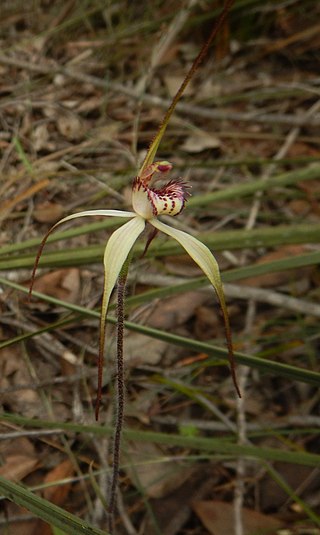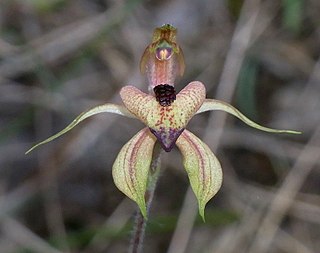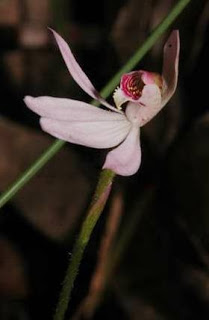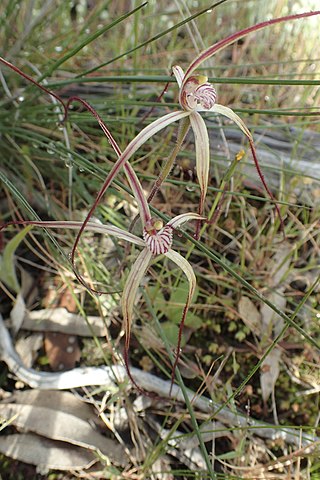Caladenia aestiva, commonly known as summer spider orchid, is a plant in the orchid family Orchidaceae and is endemic to south-eastern Australia. It is a ground orchid which grows singly or in small groups in the Australian Capital Territory and Victoria. It has one or two greenish-yellow to pale yellow flowers, often while the single, hairy leaf withers.
Caladenia ancylosa, commonly known as the Genoa spider orchid, is a plant in the orchid family Orchidaceae and is endemic to Victoria. It is a ground orchid with a single hairy leaf and a single cream-coloured flower with red markings.
Caladenia atradenia, commonly known as bronze fingers, is a plant in the orchid family Orchidaceae and is endemic to New Zealand. It is a ground orchid with a thin, hairy leaf and a thin wiry stem bearing one or two dark green or greenish red flowers with maroon or magenta markings.
Caladenia atrata, commonly known as dark caladenia is a plant in the orchid family Orchidaceae and is endemic to Tasmania. It is a ground orchid with flowers that are bright white on the front, but densely covered with black glands on the back.
Caladenia atroclavia, commonly known as the black-clubbed spider orchid, is a plant in the orchid family Orchidaceae and is endemic to south-eastern Queensland. It is a ground orchid with a single hairy leaf and a pale greenish-cream coloured flower with dark purple clubs and red patches on the petals.

Caladenia aurantiaca, commonly known as orangetip fingers, is a plant in the orchid family Orchidaceae and is endemic to Victoria, although it is also found on one Bass Strait island. It is a slender ground orchid with a single hairy leaf and one or two short-lived, orange-tipped, white flowers on a thin, wiry spike.
Caladenia bicalliata subsp. bicalliata, commonly known as the limestone spider orchid or dwarf limestone spider orchid, is a plant in the orchid family Orchidaceae and is native to the south-west of Western Australia and coastal areas of South Australia. It has a single erect, hairy leaf and one or two cream-coloured flowers with reddish-brown tips.

Caladenia brumalis, commonly known as winter spider orchid, is a plant in the orchid family Orchidaceae and is endemic to South Australia. It has an erect, hairy leaf and usually a single white to pinkish flower with darker markings. It is only found in a few places due to habitat loss and is considered to be vulnerable.

Caladenia cardiochila, commonly known as thick-lipped spider-orchid, fleshy-lipped caladenia and heartlip spider-orchid, is a plant in the orchid family Orchidaceae and is endemic to Victoria and South Australia. It is a ground orchid with a single hairy leaf and one or two yellowish-green, red-striped flowers on a thin, wiry stem.

Caladenia clarkiae, commonly known as pink caps, is a plant in the orchid family Orchidaceae and is endemic to south-eastern Australia. It is a ground orchid which grows singly or in small groups in Victoria and New South Wales. It has a single leaf and usually one or two white to pale pink flowers with darker pink tips.
Caladenia clavula, commonly known as the small-clubbed spider orchid, is a plant in the orchid family Orchidaceae and is endemic to South Australia. It is a ground orchid which grows singly or in loose groups and has a singly hairy leaf and usually a single greenish-yellow flower with red stripes.
Caladenia cleistantha is a plant in the orchid family Orchidaceae and is endemic to the south-east of Australia. It is a ground orchid which occurs as solitary plants and has a singly hairy leaf and one or two cleistogamous flowers..

Caladenia conferta, commonly known as the crowded spider orchid or coast spider-orchid, is a plant in the orchid family Orchidaceae and is endemic to a restricted area in South Australia. It is a ground orchid with a single hairy leaf, and usually a single yellowish-green flower with red markings on a wiry, hairy stalk.

Caladenia cretacea, commonly known as Stuart Mill spider orchid, is a plant in the orchid family Orchidaceae and is endemic to a small area in Victoria. It is a rare ground orchid with a single leaf and one or two white flowers on a hairy stalk.

Caladenia curtisepala, commonly known as short-hooded fingers, is a plant in the orchid family Orchidaceae and is endemic to south-eastern Australia. It is a ground orchid with a single hairy leaf, and a single white to cream-coloured flower with a white labellum with red bands.

Caladenia denticulata subsp. denticulata, commonly known as the yellow spider orchid, is a plant in the orchid family Orchidaceae and is endemic to the south-west of Western Australia. It has a single erect, hairy leaf and one or two yellowish flowers which have a white labellum with pale red markings.
Caladenia dienema, commonly known as the windswept spider-orchid, is a plant in the orchid family Orchidaceae and is endemic to Tasmania. It is a ground orchid with a single, hairy leaf and a single, variably-coloured, usually dark red flower on a thin, wiry stem 5–12 cm (2–5 in) high.

Caladenia erythronema, commonly known as the red thread spider orchid, and Nyabing spider orchid is a plant in the orchid family Orchidaceae and is endemic to the south-west of Western Australia. It has a single hairy leaf and up to three red, yellow or cream-coloured flowers with dangling, thread-like sepals and petals and a small labellum.
Caladenia flaccida, commonly known as the flaccid spider orchid, is a plant in the orchid family Orchidaceae and is endemic to eastern Australia. It is a ground orchid with a single hairy leaf and up to three cream-coloured, pinkish or red flowers with long, thread-like, glandular tips on the sepals and petals.
Caladenia helvina, commonly known as the summer spider orchid, is a plant in the orchid family Orchidaceae and is endemic to Tasmania. It is a ground orchid with a single hairy leaf and usually a single greenish-yellow to pale yellow flower with reddish teeth on the sides of the labellum and reddish calli along its mid-line.









